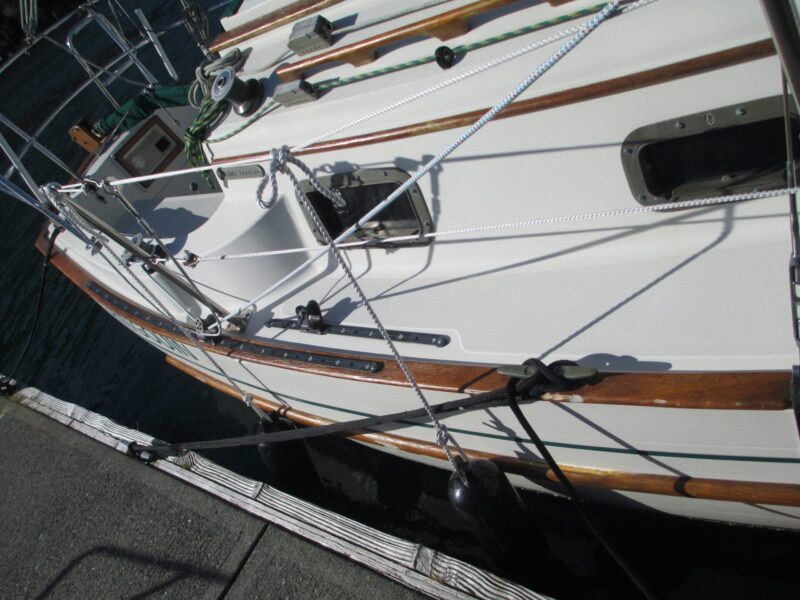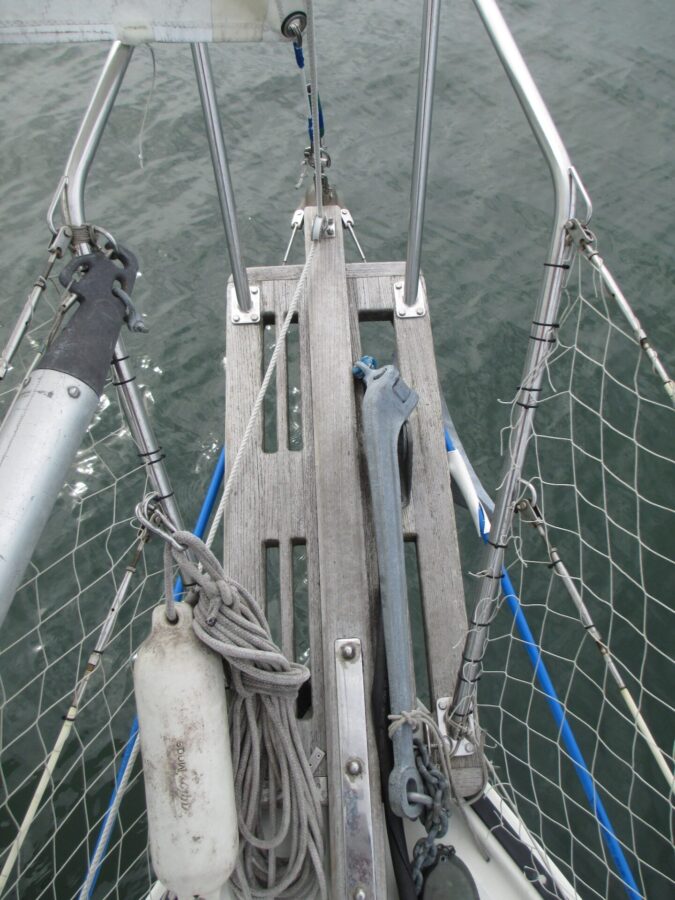
The Resourceful Sailor Asks, “Is It Varnish or Vanish?”
This installment of The Resourceful Sailor discusses the use and longevity of varnish versus paint on your boat’s wood surfaces. In our experience, most people will choose varnish — it’s traditional, it’s effective (for a time) and it looks great. But, having said that, this writer admits to having replaced varnish with paint on her own boat’s exterior trim work. Although she fought hard to keep the boat’s traditional appearance, her husband won out in the end, citing reasons very similar to those discussed below.
The Resourceful Sailor does not use varnish. Sampaguita, a 1985 Pacific Seacraft Flicka 20, has no brightwork on her. But watch the lookie-loos at the dock ogle a boat (that often never gets used) with shiny brightwork. Why? Aesthetic. The seductiveness of the bright and shiny. It is everywhere, not just with boats.
Little-known fact to a non-boater: Varnish is a serious time suck. I had a workmate, David White, whose sales pitch was that varnish was misspelled. It should really be spelled vanish. Because that’s what it does on a boat exposed to the sun’s UV radiation. After you sand and prep the surface, you need six to 10 coats of varnish, depending on your desired quality. Then you prep and recoat it with at least one coat every year. If, for some reason, you miss a year or — oh, no! — two years, you may have to sand it all off and restart.

This needs good weather, which is also the best time of the year for using the boat. I watched a fellow Flicka owner spend all of July and half of August revarnishing his outside brightwork. After all that, he said he should put another coat on, but he’d let the new owners do that. I’ve heard it said that you should only varnish your boat once: right before you are going to sell it. What a setup for the new owners!
Varnish is for what The Resourceful Sailor calls trophy boats. Go to any wooden boat festival. Wow. If that is your economy and what is important to you, to each their own. But for The Resourceful Sailor, using the boat is what’s important. I’ve known tradespeople whose sole employment was doing brightwork on boats. They do the same jobs year after year.
Varnish does create a barrier that protects the wood. However, one of the reasons it needs so many coats is to stabilize the wood and the moisture content. To cut corners is a false economy. Instead, again, the words of David White, “Slather a few coats of paint on there and go sailing.” (Hilariously, nine times out of 10, they still bought the varnish!) It will protect nearly as well for much less time and work.

Admittedly, I used to varnish my tiller. It was that one shiny element. But having learned what that small experience was like year after year, when I replaced it, I moved to painting. Phew, way easier, way faster, and one less task to distract me each year. The old tiller, I still have as a spare. And I also painted that. Fact: Both are oil-based, so the paint can successfully be put over a stable coat of varnish. Admittedly, I’ve never tried to do it the other way.

So, if you prefer using your boat over working on it, The Resourceful Sailor recommends paint over varnish. It’s not lazy if you actually go sailing. True, the lookie-loos will ogle your neighbor’s bright and shiny Flicka 20 rather than yours. The Resourceful Sailor doesn’t try to keep up with the Joneses but usually outsails them.
Remember, keep your solutions safe and prudent, and have a blast.
What is your preference for your boat’s timber work — varnish or paint? And why? Let us know in the comments below. Or if you have a lot to say, email us at [email protected].

Resourceful sailor you have written my story & experience I’ve had with my Bristol channel cutter. I live in the northwest, (Oregon), & tried to keep up with no success. The warm days with low humidity we need for varnishing are few &
days we should be sailing. One thing I could add is urethane & some other paints should not be used on high humidity days also. Anything above 70% has too much moisture & can ruin a good paint job.
Robert, Thanks for reading. I had a dream of a BCC at one point. They are a lot of work. I hope you get out sailing often.
I love seeing the wood grain and I love seeing my old wooden boat show off the beauty of wood.
Thanks for reading Dennis. I sure you have beautiful boat.
a 2-part polyurethane might be a good choice. Awlgrip, Alex Seal, Sherwin Williams…??
Varnish , protects wood from the elements . And exposes it to the critics .
Mark, Thanks for reading. Nice ironic word play.
In the Arts, they say “do it for the exposure.” Which is another term for frostbite and heatstroke.
Dennis, Thanks for stopping by. Good to have you. Interlux used to have one too. Not sure if they still do. I’ve never used them. The RS is more of a function over fashion sort of guy. I wonder if the two parts might crack under the expansion and contraction of wood? I’d have to ask a paint pro. Dave White, who actually owns a vintage wooden boat, wasn’t shy about suggesting hardware store Rust-Oleum to people. It doesn’t give the yachtie finish but protects it just as well at a fraction of the cost of a marine paint.
Josh—I think you must be my long lost younger brother. Every time I read one of your articles, I get this overwhelming feeling of ‘simpatico solidarity’ for lack of a better term. I totally agree with your views on varnish/vanish. After refinishing my teak handrails for the first (and last) time. I thought, why would anyone willingly put a wooden accessory on a boat? I am definitely a function-over-beauty boater, and I LOVE the look of your unfinished bowsprit! BTW, I did an experiment with two identical winch baseplates, both made of teak. I coated one with multiple coats of varnish and the other with a single coat of UV stabilized epoxy. Take a guess which looked better after two years of being exposed to two years of PNW weather … 😀⛵️😀
Jay, thanks for reading and the kind words. The previous owner put the teak bowsprit on there. It’s very heavy, but easy to maintain. The original would have been spruce, I think, which would definitely require a coating. Keep sailing.
I’ve lived on both sides of paint and varnish saga for over 60 years, and can say that just a little brightwork is worth it….as long as you don’t let it keep tou off the water. If you miss a varnishing window, and you lose it, you’ll be fine starting over if doing just a couple handrails and hatchboards. I’ve found that oils, cetol, etc don’t ever match the sexiness of varnish, but sttill need attention. 2-part varnish is too brittle, and can crack off of teak. Boats aren’t pianos, but they do like a little lipstick.
Goose, thanks for reading and chiming in. There is a reason why the eye candy of varnish is so popular. And a reason why work boats don’t bother. That was my guess on the two-part products too.
I always say ‘don’t put anything on teak that you later have to sand off’. Pure tung nut oil mixed 70 parts to 30 parts solvent and apply sparingly with a minimum of 3 hardened layers. After you have a base apply in spring to make it look pretty and in the fall for protection. It is simply a wipe on with a rag to maintain and followed with a clean rag buffing. It won’t crack or chip like varnish. Ken / Island Teak
Ken, thanks for reading.